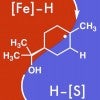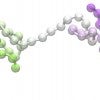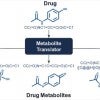
Malaria test as simple as a bandage
HOUSTON – (Nov. 2, 2020) – Testing for malaria could become as simple as putting on a bandage.

Malaria test as simple as a bandage
HOUSTON – (Nov. 2, 2020) – Testing for malaria could become as simple as putting on a bandage.

In a hurry to develop drugs? Here’s your cHAT
Rice University scientists develop cHAT to simplify the reduction of alkenes to more useful intermediate molecules for drugs and other useful chemical compounds.

Flash graphene rocks strategy for plastic waste
Rice scientists advance their technique to make graphene from waste with a focus on plastic.

US wealth, income inequality has declined, Baker Institute expert finds
HOUSTON – (Oct. 28, 2020) – Analysis of Federal Reserve survey data shows U.S. wealth inequality has declined for the first time in nearly 30 years, while income inequality has seen its largest decline in three decades, according to a new working paper from Rice University's Baker Institute for Public Policy.

At our cores, we’re all strengthened by ‘dumbbells’
Scientists at Rice’s Center for Theoretical Biological Physics detail the structure of dumbbell-like sequences in DNA during interphase that suggest several unseen aspects of chromosome configuration and function.

A trillion turns of light nets terahertz polarized bytes
Nanophotonics researchers at Rice University, the Polytechnic University of Milan and the Italian Institute of Technology have demonstrated a novel technique for modulating light at terahertz frequencies with plasmonic metasurfaces.

Haotian Wang wins Packard Fellowship
Haotian Wang has been honored with a Packard Fellowship, one of 20 researchers in the nation to do so this year.

NSF renews Rice-based NEWT Center for water treatment
The National Science Foundation renews the Rice-based Nanotechnology Enabled Water Treatment Center for five years. The Engineering Research Center is dedicated to enabling access to clean water around the world.

Study: Darwin's theory about coral reef atolls is fatally flawed
Rice marine geologist and oceanographer André Droxler knows Charles Darwin's theory about atoll formation is incorrect, and Droxler and former Rice postdoc Stéphan Jorry are hoping to set the record straight with a comprehensive new paper about the subject.

Literal rise of the internet enables new climate science
Collaborative National Science Foundation grants will use data from internet balloons to study atmospheric gravity waves and their influence on the weather and climate.

There’s a reason bacteria stay in shape
A primal mechanism in bacteria that keeps them in their personal Goldilocks zones -- that is, just right -- appears to depend on two random means of regulation, growth and division, that cancel each other out. The same mechanism may give researchers a new perspective on disease, including cancer.

Earth grows fine gems in minutes
Aquamarine, emerald, garnet, zircon and topaz are but a few of the crystalline minerals found mostly in pegmatites, veinlike formations that commonly contain both large crystals and hard-to-find elements like tantalum and niobium. Another common find is lithium, a vital component of electric car batteries.

Deep learning gives drug design a boost
A computational tool created at Rice University may help pharmaceutical companies expand their ability to investigate the safety of drugs.

Gemini South's high-def version of 'A Star is Born'
NASA's James Webb Space Telescope is still more than a year from launching, but the Gemini South telescope in Chile has provided astronomers from Rice University and Dublin City University a glimpse of what the orbiting observatory should deliver.

Baker Institute, American Academy of Arts and Sciences: US innovation edge in peril
A sweeping new report urges significant policy and funding action to ensure the United States does not lose the preeminent position in discovery and innovation it has built since the end of World War II.